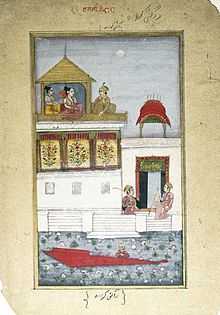Kedar (raga)
| Hindustani classical music |
|---|
| Concepts |
| Genres |
| Thaats |

Kedar, also known as Kedara, is a Hindustani classical raga. Named after Lord Shiva, the raga is placed on a high pedestal in the realms of Indian classical music. It is characterised by a lot of complex turns, which are brilliantly melodious but difficult to express in words.
Origin
The raga emerges from the Kalyan thaat.
Technical description
The raga is of shaadava-sampurna nature, i.e., in its arohana (ascent), only six notes are used, and in avarohana (descent), all seven notes are used. In general, the progression of the raga is highly non-linear, which makes it difficult to capture the essence of the raga using arohana and avarohana. The raga uses only natural (shuddha) versions of the Second (R), Third (G) and Sixth (D), both natural and sharp (tivra) versions of the Fourth (m and M, respectively), and predominantly natural versions of the Seventh (N) but occasionally also its flat (komal) version (n). ( m- teevra, M- shuddh)
Arohana: S M ~P, m P D n ~D P, m P S'
Avarohana: S' N D P , m P D P M~ , S R S
Pakad: S M , M P, m P m P, D P M, R S
The most prominent (vadi) note is S, and the second most prominent (samvadi) is m.
Samay (time)
The raga is to be sung in the night. It is sung in the second prahar of night.
Mostly the Ragas with teevra ma(M) are sung at night (as per the time theory of Ragas)
Further Information
The meend from D to M via P is the heart of the raga. The G is used lightly as a grace note in the transition from m to P. The movements in the raga from one swara to another are quite complicated, and the extent of use of the different swaras often depends on the singer. Kedar is an ancient raga, with different genres of classical songs, like khayals, thumris, dhrupads, as well as light classical songs based on it.
External links
- Raga Kedar - A Perspective
- SRA on Samay and Ragas
- SRA on Ragas and Thaats
- Rajan Parrikar on Ragas
- Film Songs in Rag Kedar